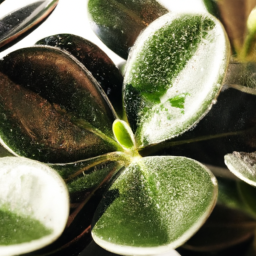
Creating a healthier home is a goal that many of us strive for, and one effective way to achieve this is through the science behind indoor plant air purification. Indoor air quality can have a significant impact on our overall well-being, and by incorporating certain types of plants into our living spaces, we can naturally improve the air we breathe. In this blog post, we will explore the fascinating science behind how indoor plants purify the air, and discover which plants are most effective in creating a healthier home environment. So, if you’re looking to enhance the air quality in your home and reap the benefits of cleaner, fresher air, keep reading to learn more about the power of indoor plant air purification.
The Benefits of Indoor Plants for Air Purification
Indoor plants not only add beauty and a touch of nature to your home, but they also have numerous benefits when it comes to air purification. In this article, we will explore the science behind how indoor plants can help create a healthier home environment.
How Indoor Plants Improve Air Quality
Indoor air pollution is a significant concern, as it can lead to various health issues. However, certain indoor plants have the ability to naturally purify the air by removing harmful pollutants and releasing oxygen. This process, known as phytoremediation, is backed by scientific research and has been proven effective in improving indoor air quality.
Plants absorb pollutants through their leaves and roots, breaking them down into harmless compounds. They can effectively remove common indoor pollutants such as formaldehyde, benzene, and trichloroethylene, which are often found in household items like carpets, furniture, and cleaning products. By introducing indoor plants into your home, you can significantly reduce the levels of these harmful substances in the air.
Furthermore, plants release moisture vapor through a process called transpiration. This increases humidity levels in the surrounding air, which can help alleviate dryness and respiratory problems. Adequate humidity levels also make it more difficult for airborne viruses and bacteria to survive, thus reducing the risk of respiratory infections.
Choosing the Right Indoor Plants
Not all indoor plants are equally effective in purifying the air. Some plants have higher rates of pollutant absorption and are more efficient in improving air quality. When selecting indoor plants for air purification, consider the following:
1. Spider Plant (Chlorophytum comosum): This popular houseplant is known for its ability to remove formaldehyde, xylene, and carbon monoxide from the air. It is easy to care for and can thrive in various lighting conditions.
2. Peace Lily (Spathiphyllum): The peace lily is excellent at removing common indoor pollutants, including benzene, formaldehyde, trichloroethylene, and ammonia. It also adds a touch of elegance to any room with its beautiful white flowers.
3. Snake Plant (Sansevieria trifasciata): Also known as “mother-in-law’s tongue,” the snake plant is highly effective in removing formaldehyde, benzene, and xylene from the air. It is a hardy plant that requires minimal care, making it perfect for beginners.
Remember to consider your home’s lighting conditions and the specific pollutants you want to target when choosing indoor plants for air purification. Having a variety of plants can also provide a more comprehensive air purification effect.
Caring for Indoor Plants
Proper care is essential to ensure that your indoor plants thrive and continue to purify the air effectively. Here are some general tips for caring for indoor plants:
1. Watering: Most indoor plants prefer slightly moist soil. Avoid overwatering, as it can lead to root rot. Check the soil moisture regularly and water only when the top inch of soil feels dry.
2. Light: Different plants have varying light requirements. Place your plants in areas that receive adequate light for their specific needs. Consider using artificial grow lights if natural light is limited.
3. Fertilization: Indoor plants generally require less fertilization compared to outdoor plants. Use a balanced, water-soluble fertilizer once a month during the growing season to provide essential nutrients.
4. Pest Control: Keep an eye out for common indoor plant pests such as aphids, mealybugs, and spider mites. Regularly inspect your plants and take appropriate measures to control any infestations.
By following these care tips, you can maintain healthy indoor plants that continue to purify the air and contribute to a healthier home environment.
In conclusion, indoor plants offer numerous benefits when it comes to air purification. Their ability to remove harmful pollutants and increase humidity levels makes them an excellent addition to any home. By selecting the right plants and providing proper care, you can create a healthier living space for you and your family.
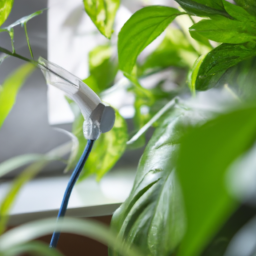
Understanding the Science Behind Indoor Plant Air Purification
Welcome to our step-by-step guide on creating a healthier home through indoor plant air purification. In this article, we will delve into the fascinating science behind how plants can improve the quality of the air we breathe. So, let’s dive right in and explore the wonders of indoor plant air purification!
What is Indoor Plant Air Purification?
Indoor plant air purification refers to the process by which certain plants help remove toxins and pollutants from the air, making it cleaner and healthier to breathe. This natural air purification method has gained popularity in recent years due to its effectiveness and numerous health benefits.
Plants have the incredible ability to absorb harmful gases and chemicals through their leaves and roots, converting them into nutrients for their growth. They act as natural air filters, removing pollutants such as formaldehyde, benzene, and trichloroethylene, which are commonly found in indoor environments.
By incorporating indoor plants into your home, you can create a healthier living space and improve the overall air quality. Now, let’s explore the science behind how these amazing plants purify the air.
How Do Plants Purify the Air?
Plants purify the air through a process called phytoremediation. This process involves the plants’ ability to absorb and break down pollutants, rendering them harmless. Here’s a breakdown of the steps involved:
1. Absorption: Plants absorb pollutants primarily through tiny openings on their leaves called stomata. These stomata allow gases to enter the plant, where they are then transported to the roots.
2. Rhizosphere: The rhizosphere, which is the area surrounding the roots, plays a crucial role in air purification. It contains beneficial microorganisms that work in symbiosis with the plant roots, helping to break down and neutralize pollutants.
3. Microbial Activity: The microorganisms in the rhizosphere release enzymes that break down the absorbed pollutants into less harmful substances. This microbial activity is a key component of the air purification process.
4. Plant Uptake: Once the pollutants are broken down, the plants absorb the transformed substances through their roots. These substances are then utilized by the plant for growth and development.
5. Clean Air Release: As the plants continue to absorb pollutants, they release clean, purified air back into the environment. This continuous cycle ensures a healthier indoor air quality.
Choosing the Right Plants for Indoor Air Purification
Not all plants are equally effective at purifying the air. Some species have a higher capacity to remove specific pollutants, making them more suitable for indoor air purification. Here are a few plants that have shown exceptional air purifying abilities:
1. Snake Plant (Sansevieria trifasciata): This popular indoor plant is known for its ability to remove formaldehyde, xylene, and toluene from the air. It is low-maintenance and can thrive in various lighting conditions.
2. Peace Lily (Spathiphyllum): The peace lily is highly efficient at removing common indoor pollutants, including benzene, trichloroethylene, and ammonia. It also adds a touch of elegance to any room with its beautiful white flowers.
3. Spider Plant (Chlorophytum comosum): Spider plants are excellent at removing formaldehyde, carbon monoxide, and xylene. They are easy to care for and produce small plantlets, making them great for propagation.
These are just a few examples, and there are many other plants that can contribute to indoor air purification. It’s important to consider factors such as lighting, maintenance requirements, and personal preferences when selecting plants for your home.
By incorporating these air-purifying plants into your indoor space, you can create a healthier and more enjoyable environment for you and your family.
Conclusion
Understanding the science behind indoor plant air purification can help you create a healthier home environment. By harnessing the natural abilities of plants to absorb and neutralize pollutants, you can significantly improve the air quality in your living space. Remember to choose the right plants for indoor air purification and enjoy the benefits of cleaner, fresher air. So go ahead, bring some greenery into your home and breathe easy!
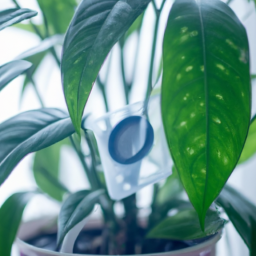
How to Choose the Right Indoor Plants for Air Purification
The Importance of Indoor Plants for Air Purification
Indoor air pollution is a growing concern in today’s world, with various pollutants such as volatile organic compounds (VOCs), formaldehyde, and allergens present in our homes. These pollutants can have detrimental effects on our health, leading to respiratory issues, allergies, and even long-term illnesses. However, there is a natural and effective solution to combat indoor air pollution – indoor plants.
Indoor plants have been proven to purify the air by filtering out harmful toxins and releasing oxygen. They act as natural air purifiers, enhancing the overall air quality in our homes. Not only do indoor plants contribute to a healthier environment, but they also add beauty and a sense of tranquility to any space. Now, let’s explore how to choose the right indoor plants for air purification.
Consider Your Space and Lighting Conditions
Before selecting indoor plants for air purification, it’s essential to assess your space and lighting conditions. Different plants have varying light requirements, and it’s crucial to choose plants that will thrive in your specific environment. Take note of the amount of natural light your space receives and whether there are any shaded areas.
If your space has abundant natural light, you can opt for plants that require bright, indirect sunlight, such as the Snake Plant (Sansevieria trifasciata) or Peace Lily (Spathiphyllum). These plants are known for their air-purifying properties and are relatively low-maintenance. On the other hand, if your space has limited natural light, you can choose plants like the ZZ Plant (Zamioculcas zamiifolia) or Cast Iron Plant (Aspidistra elatior), as they can thrive in low-light conditions.
Additionally, consider the size of your space and the available floor or shelf space for your plants. Some plants, like the Fiddle Leaf Fig (Ficus lyrata) or Monstera (Monstera deliciosa), can grow quite large and may not be suitable for smaller spaces. Opt for smaller plants like the Spider Plant (Chlorophytum comosum) or Pothos (Epipremnum aureum) if you have limited space.
Identify Air-Purifying Plants
While all plants contribute to a healthier indoor environment by releasing oxygen, some plants are particularly effective at filtering out pollutants. When selecting indoor plants for air purification, it’s beneficial to choose those that have been scientifically proven to remove toxins from the air.
One such plant is the Aloe Vera (Aloe barbadensis). Not only does it have air-purifying properties, but it also releases oxygen at night, making it an excellent choice for bedrooms. The Spider Plant is another popular choice, as it effectively removes formaldehyde and xylene from the air. Other air-purifying plants include the Boston Fern (Nephrolepis exaltata), Peace Lily, and Bamboo Palm (Chamaedorea seifrizii).
It’s worth noting that different plants target specific pollutants, so incorporating a variety of air-purifying plants can provide comprehensive indoor air purification. Consider creating a diverse collection of plants to maximize their air-purifying benefits.
Consider Maintenance and Care Requirements
When selecting indoor plants for air purification, it’s essential to consider your ability to provide the necessary care and maintenance. Some plants require more attention, while others are more forgiving and can thrive with minimal care.
If you have a busy schedule or are new to plant care, opt for low-maintenance plants like the Snake Plant or Pothos. These plants are known for their resilience and can tolerate irregular watering or occasional neglect. On the other hand, if you enjoy tending to plants and have the time to dedicate to their care, you can choose more high-maintenance plants like the Orchid (Orchidaceae) or Maidenhair Fern (Adiantum spp.).
Consider factors such as watering frequency, humidity requirements, and the need for pruning or repotting when selecting indoor plants. By choosing plants that align with your lifestyle and care abilities, you can ensure their long-term health and maximize their air-purifying benefits.
Creating a healthier home through indoor plant air purification is a rewarding and scientifically-backed endeavor. By considering your space and lighting conditions, identifying air-purifying plants, and taking maintenance requirements into account, you can choose the right indoor plants for air purification. Not only will these plants enhance the air quality in your home, but they will also add beauty and a sense of tranquility to your living space. Start incorporating indoor plants today and experience the benefits of a healthier home.
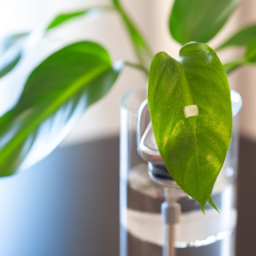
Creating an Effective Indoor Plant Air Purification System
The Importance of Indoor Air Quality
Indoor air quality plays a crucial role in our overall health and well-being. Poor air quality can lead to various respiratory issues, allergies, and even long-term health problems. With the increasing amount of time we spend indoors, it is essential to create a healthier home environment. One effective way to improve indoor air quality is by incorporating indoor plants into your living space.
Indoor plants not only add beauty and freshness to your home but also have the remarkable ability to purify the air we breathe. Through a process called phytoremediation, plants can remove harmful toxins and pollutants from the air, making it cleaner and healthier for us to inhale.
In this guide, we will explore the science behind indoor plant air purification and provide you with step-by-step instructions on creating an effective indoor plant air purification system.
Step 1: Choosing the Right Plants
The first step in creating an effective indoor plant air purification system is selecting the right plants for your home. Not all plants are equally efficient at purifying the air, so it’s essential to choose the ones that are known for their air-cleaning abilities.
Some of the best plants for air purification include the Spider Plant, Peace Lily, Boston Fern, Snake Plant, and Aloe Vera. These plants are not only aesthetically pleasing but also highly effective at removing common indoor pollutants like formaldehyde, benzene, and xylene.
When selecting plants, consider the size of your space and the amount of natural light it receives. Different plants have different light requirements, so choose plants that will thrive in your specific environment.
Step 2: Placement and Arrangement
Once you have chosen the right plants, it’s time to think about their placement and arrangement in your home. To maximize their air purification capabilities, it’s important to strategically place the plants in areas where air circulation is good.
Consider placing plants near windows or doors, as these areas tend to have better air movement. You can also create clusters of plants to enhance their collective air-cleaning power. However, avoid overcrowding the plants, as they need space to grow and thrive.
Additionally, placing plants in bedrooms and living areas where you spend the most time can have a significant impact on your indoor air quality. Just a few well-placed plants can make a noticeable difference in the air you breathe.
Step 3: Caring for Your Plants
To maintain an effective indoor plant air purification system, it’s crucial to provide proper care and maintenance to your plants. Here are a few essential tips:
Watering: Different plants have different watering needs, so make sure to research and understand the water requirements of each plant. Overwatering can lead to root rot, while underwatering can cause the plants to wither.
Lighting: Most indoor plants thrive in bright, indirect light. Place them near windows or use artificial grow lights to provide adequate lighting for their growth.
Fertilizing: Indoor plants generally require less frequent fertilization compared to outdoor plants. Use a balanced, water-soluble fertilizer and follow the instructions on the packaging.
Pest Control: Keep an eye out for pests like aphids or spider mites, as they can damage your plants. Use organic pest control methods or consult with a local garden center for appropriate solutions.
By providing the right care and attention to your indoor plants, you can ensure they thrive and continue to purify the air in your home effectively.
Conclusion
Creating an effective indoor plant air purification system is a simple and natural way to improve the air quality in your home. By carefully selecting the right plants, strategically placing them, and providing proper care, you can create a healthier environment for you and your family.
Remember, indoor plants are not a substitute for proper ventilation and regular cleaning, but they can significantly contribute to cleaner and fresher indoor air. So, go ahead and start incorporating indoor plants into your home to enjoy the numerous benefits they offer.
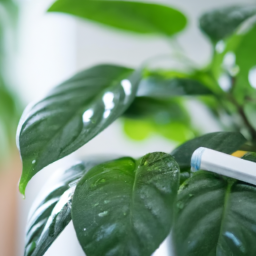
Tips for Maintaining a Healthy Indoor Environment with Plants
Introduction
Indoor plants not only add beauty and life to our homes but also play a vital role in purifying the air we breathe. They have the incredible ability to remove harmful toxins and release oxygen, making our indoor environment healthier and more pleasant. In this article, we will explore the science behind indoor plant air purification and provide you with valuable tips on creating a healthier home.
The Science Behind Indoor Plant Air Purification
Indoor air pollution is a significant concern, with various sources such as volatile organic compounds (VOCs) from furniture, cleaning products, and even our own breath. These pollutants can lead to respiratory issues, allergies, and other health problems. However, indoor plants have been proven to effectively remove these pollutants from the air.
Plants purify the air through a process called phytoremediation. They absorb pollutants through their leaves and roots, breaking them down into harmless compounds. Additionally, plants release moisture through a process known as transpiration, which helps increase humidity levels and reduce airborne pollutants.
Choosing the Right Plants
Not all plants are equally effective at purifying the air. When selecting plants for your indoor environment, consider their air-purifying capabilities. Some of the best plants for improving indoor air quality include:
1. Snake Plant (Sansevieria): This plant is known for its ability to remove toxins like formaldehyde and benzene from the air. It is also incredibly low-maintenance, making it perfect for beginners.
2. Peace Lily (Spathiphyllum): The peace lily is not only aesthetically pleasing but also an excellent air purifier. It can remove common indoor pollutants like ammonia, benzene, and formaldehyde.
3. Spider Plant (Chlorophytum comosum): Spider plants are known for their ability to remove formaldehyde and xylene from the air. They are also pet-friendly, making them a great choice for households with furry friends.
Caring for Indoor Plants
To ensure that your indoor plants continue to purify the air effectively, proper care is essential. Here are some tips for maintaining healthy indoor plants:
1. Provide Adequate Lighting: Most indoor plants thrive in bright, indirect light. Place your plants near windows or provide artificial lighting if natural light is limited.
2. Watering: Different plants have different watering needs. Avoid overwatering or underwatering your plants. Check the soil moisture regularly and water accordingly.
3. Proper Drainage: Ensure that your pots have drainage holes to prevent water from pooling at the bottom. Excess water can lead to root rot and other plant diseases.
4. Regular Dusting: Dust can accumulate on plant leaves, hindering their ability to photosynthesize effectively. Wipe the leaves gently with a damp cloth to remove dust and keep them clean.
5. Fertilization: Indoor plants require occasional fertilization to thrive. Use a balanced, water-soluble fertilizer and follow the instructions on the packaging.
6. Pruning: Trim any dead or yellowing leaves to promote healthy growth. Pruning also helps maintain the shape and size of your plants.
Conclusion
Creating a healthier home with indoor plants is not only aesthetically pleasing but also scientifically proven to improve indoor air quality. By understanding the science behind indoor plant air purification and following the tips mentioned above, you can create a healthier indoor environment for you and your loved ones. So go ahead, bring in some greenery, and enjoy the benefits of a healthier home!
In a Nutshell
Indoor air quality is a crucial aspect of creating a healthier home environment, and one effective way to improve it is by incorporating indoor plants. You might be wondering, how do plants actually purify the air? Well, it all comes down to science.
Plants have the remarkable ability to absorb harmful pollutants through their leaves and roots, effectively cleansing the air we breathe. They act as natural air filters, removing toxins such as formaldehyde, benzene, and trichloroethylene, which are commonly found in household products and materials. Through a process called phytoremediation, plants convert these harmful substances into nutrients, improving the overall air quality in your home. Not only do they filter out pollutants, but plants also release oxygen and increase humidity, creating a more refreshing and comfortable living space. So, next time you’re thinking about sprucing up your home decor, consider adding some greenery to enhance both the aesthetic appeal and the air quality of your home.
Frequently Asked Questions from our readers:
Q1: How do indoor plants help purify the air in our homes?
A1: Indoor plants have the remarkable ability to naturally purify the air by removing harmful pollutants and toxins. Through a process called photosynthesis, plants absorb carbon dioxide and release oxygen, improving the air quality in our homes.
Q2: Which indoor plants are most effective at air purification?
A2: Several indoor plants are known for their exceptional air-purifying properties. Some popular choices include the peace lily, snake plant, spider plant, aloe vera, and pothos. These plants have been scientifically proven to filter out various airborne pollutants, such as formaldehyde, benzene, and trichloroethylene.
Q3: How many indoor plants do I need to effectively purify the air in my home?
A3: The number of plants needed to purify the air in your home depends on various factors, including the size of the space and the specific plants you choose. As a general guideline, having one medium-sized plant per 100 square feet of living space is recommended for optimal air purification.
Q4: Can indoor plants reduce the presence of allergens in the air?
A4: Yes, indoor plants can help reduce the presence of allergens in the air. Plants can trap and remove airborne particles, including dust, pollen, and mold spores, which can alleviate allergy symptoms and improve overall air quality.
Q5: Do indoor plants release any harmful substances into the air?
A5: While indoor plants are generally beneficial for air purification, some plants may release small amounts of volatile organic compounds (VOCs) during certain conditions. However, the overall air-purifying benefits of indoor plants outweigh any potential VOC emissions, and the levels are typically minimal and safe for humans.
Q6: Do indoor plants require any special care to maintain their air-purifying capabilities?
A6: To maintain the air-purifying capabilities of indoor plants, it is important to provide them with proper care. This includes regular watering, adequate sunlight or artificial light, appropriate temperature and humidity levels, and occasional fertilization. Additionally, keeping the leaves clean by gently wiping them can enhance their air-purifying efficiency.
Q7: Can indoor plants improve mental health and well-being?
A7: Yes, indoor plants have been shown to have positive effects on mental health and well-being. Studies indicate that having plants indoors can reduce stress, improve mood, increase productivity, and enhance overall feelings of well-being. The presence of greenery can create a calming and soothing environment, promoting a healthier home atmosphere.
Q8: Are there any specific plants that are beneficial for reducing indoor air pollution?
A8: Yes, certain plants are particularly effective at reducing specific indoor air pollutants. For example, the peace lily is excellent at removing formaldehyde, while the snake plant excels at filtering out benzene and trichloroethylene. Researching the specific pollutants you are concerned about can help you choose the most suitable plants for your needs.
Q9: Can indoor plants help improve indoor air quality in homes with pets?
A9: Indoor plants can indeed help improve indoor air quality in homes with pets. Pets can introduce allergens and dander into the air, which plants can help filter out. Additionally, some plants have air-purifying properties that can neutralize pet odors, making the air fresher and more pleasant.
Q10: Can indoor plants replace the need for mechanical air purifiers?
A10: While indoor plants are effective at purifying the air to some extent, they cannot completely replace the need for mechanical air purifiers in certain situations. Mechanical air purifiers are designed to filter out smaller particles and can be more efficient in combating specific air quality issues. However, incorporating indoor plants alongside mechanical air purifiers can provide a comprehensive approach to improving indoor air quality.
Dr. Olivia Green is a botanist with over two decades of experience in indoor plant cultivation. She holds a Ph.D. in Plant Biology and has dedicated her career to researching plant behavior in controlled environments. Dr. Green is passionate about helping plant enthusiasts master the art of indoor gardening through her extensive knowledge and practical insights.


